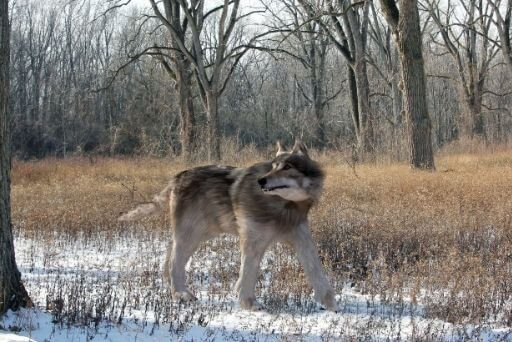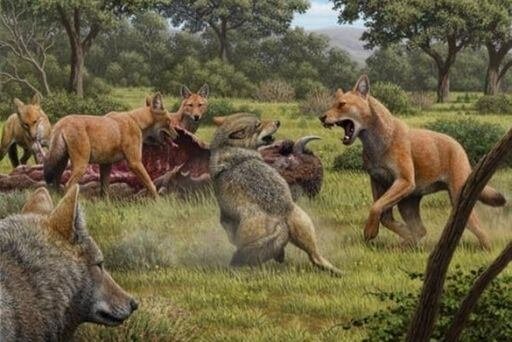Unveiling the Myth: The Dire Wolf – Factual Beast or Fictional Legend?
Wolves have been fascinating characters, whether in fictional novels or real life. Different types are distinctive from one another.
We have always imagined dire wolves with reddish furs. Even before they were introduced as fictional pets in Game of Thrones, this amazing creatures were captured in our imaginations. These wolves weigh around 150 pounds and are possibly larger and heavier than gray wolves. And we were left thinking: are dire wolves real?
Straight to the point: are dire wolves real?
The simple answer to this question is no, dire wolves are no longer real. They were once a real species that roamed the Earth thousands of years ago, but they have since gone extinct. The idea of dire wolves as fictional creatures or pets is purely based on our imagination and creative interpretations.
What were dire wolves?
Dire wolves (canis dirus) were large, wolf-like canines that lived during the Pleistocene period, around 125,000 to 10,000 years ago. They were native to North and South America and were believed to have evolved from smaller ancestors who crossed the Bering land bridge from Eurasia.
How did dire wolves become extinct?
These dire wolves used to roam on American lands and prey on megafauna that is now extinct, like ground sloths and Ice Age horses. However, not much is known about they. How were they? Where did they come from? How different were they? Why and how did they die 13,000 years ago?
In the first few studies, researchers were able to analyze full genomes that revealed quite a few surprises. Instead of sharing close genetic relations with the gray wolf, they only showcased some resemblances with them.
Research facts
Angela Perri, an archaeologist, Durham University, states that morphologically gray and dire wolves look similar, but their genetics are not even closely related.
There have been new findings that place dire wolves howl a new world lineage that split from the ancestors of gray wolves 5.5 million years ago.
Perri stressed the question of whether their extinction resulting from climate and environmental changes or humans or other dogs and wolves contributed to wiping them out,.

Credit: Aunt_Spray iStock
The Dreadful Gray Wolves
The dire wolf was once categorized in the genus Aenocyon, i.e., dreadful or terrible. It is a mythological implication that directly indicates their huge size and string back teeth. Dire wolves one of the remarkable animals that once roamed the world with huge sloths, cats, and camels. These are among those animals who could not get adapted to the changing world scenario and perished.
The imaginations of dire wolves had always roamed in Perri’s mind even before these studies came to light. She has always thought that dire wolves were present at the time humans appeared. Did both dire wolves and humans share the same timeline?
When she started studies on dire wolves, she knew there would be one place where there would be no scarcity of this creature fossils, i.e., Los Angeles. However, the past efforts of extracting fossils from La Brea have failed. The site has harsh environmental conditions making it impossible for smooth extraction.
The tar pit present at the site is a bubbly mess filled with tar that is not at all favorable for DNA preservation. One of La Brea’s extraction was successful, and they got a sample of DNA. It was a protein sequence that allowed researchers to compare dire wolves with coyotes, gray wolves, African wolves, and dogs. However, in the end, it was concluded that dire wolves were different from all.

The Dire Wolf Real Hunt
The DNA from a protein sequence was not enough; the team needed more to find some staunch results. Laurent Frantz from the Queen Mary University of London said that protein sequence is not enough to find the lineage of an entire species.
Perri also strolled through museums and universities in the United States in search of dire wolf bone, in the quest to find more DNA. The trip was not as exciting as it may seem. Perri has to explain every time to the airport authorities why she has bone fragments, tooth splinters, and electronic measuring devices with her.
But the hard work paid off, and she and her colleagues were able to collect some samples. The research team was able to find out that dire wolves are totally different from other wolves. The research also revealed that dire wolves were not as closely related to the gray wolf as compared to African golden and Indian wolves.

Dire Wolf Fossils & 10 Facts about Dire Wolves
The fossils of dire wolves have been found in various regions of North and South America, including California, Florida, Texas, and Peru. These fossils include skulls, teeth, bones, and even entire skeletons that provide valuable information about their appearance and behavior.
Some interesting facts about dire wolf fossils:
- The dire wolf was once known as the terrible wolf, a name that reflected its imposing size and strong back teeth.
- Dire wolf samples and dire wolf remains, including skulls, teeth, bones, and complete skeletons, have been discovered across North and South America.
- Dire wolf DNA analysis has revealed that this extinct species has a distinct lineage, deviating from the ancestors of the gray wolf some 5.5 million years ago.
- Dire wolf populations once roamed widely across the continent, with fossils found in areas from California to Florida, and as far south as Peru.
- Despite the morphological similarities between dire and gray wolves, genetic analyses show that they are quite distinct, with the gray wolf resembling the African golden wolf and Indian wolf more closely than the dire wolf.
- Only about 2 out of every 9 modern gray wolves have genetic markers that align with those found in dire wolf DNA, further highlighting the distinct dire wolf lineage.
- The extinction of the dire wolf population coincided with the decline of Ice Age megafauna in North America, suggesting a potential dependence on these large prey species.
- Although dire wolves and gray wolves both existed in North America, there is no evidence to suggest they interbred or shared significant portions of their genomes.
- Interestingly, some researchers have likened the genetic difference between dire wolves and modern gray wolves to the difference between gray wolves and the African wild dog.
- The first dire wolf identified from DNA was discovered in the La Brea tar pits, despite the challenging environmental conditions for DNA preservation at this site.
Conclusion: Are Dire Wolves Real?
In conclusion, dire wolves were a real species that once roamed the North American continent alongside other Ice Age megafauna. Their distinct lineage and unique genetic makeup set them apart from their close relatives, the gray wolves. Despite their impressive size and strength, they were unable to adapt to changing environmental conditions and ultimately became extinct. Through continued research and study of dire wolf fossils, we can continue to learn more about this formidable and fascinating creature. So, dire wolves were indeed real and not just a mythological creature from fantasy novels and TV shows. Dire wolf fossils and DNA evidence provide concrete proof of their existence and add to our understanding of the diverse species that have inhabited our planet throughout history.




